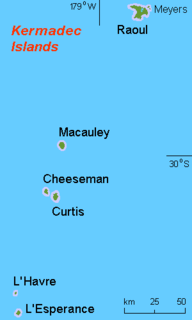
The Kermadec Islands are a subtropical island arc in the South Pacific Ocean 800–1,000 km (500–620 mi) northeast of New Zealand's North Island, and a similar distance southwest of Tonga. The islands are part of New Zealand, 33.6 km2 (13.0 sq mi) in total area and uninhabited, except for the permanently manned Raoul Island Station, the northernmost outpost of New Zealand.
This is a timeline of environmental history of New Zealand. It includes notable events affecting the natural environment of New Zealand as a result of human activity.

Aotea Harbour is a settlement and smallest of three large natural inlets in the Tasman Sea coast of the Waikato region of New Zealand's North Island. It is located between Raglan Harbour to the north and Kawhia Harbour to the south, 30 kilometres southwest of Hamilton.

Coprosma robusta, commonly known as karamu, is a flowering plant in the family Rubiaceae. It can survive in many climates, but is most commonly found in coastal areas, lowland forests, or shrublands. Karamu can grow to be around 6 meters tall, and grow leaves up to 12 centimeters long. Karamu is used for a variety of purposes in human culture. The fruit that karamu produces can be eaten, and the shoots of karamu are sometimes used for medical purposes.

Coprosma is a genus of flowering plants in the family Rubiaceae. It is found in New Zealand, Hawaiian Islands, Borneo, Java, New Guinea, islands of the Pacific Ocean to Australia and the Juan Fernández Islands.

The stitchbird or hihi is a honeyeater-like bird endemic to the North Island and adjacent offshore islands of New Zealand. Its evolutionary relationships have long puzzled ornithologists, but it is now classed as the only member of its own family, the Notiomystidae. It became rare, being extirpated everywhere except Little Barrier Island, but has been reintroduced to two other island sanctuaries and four locations on the North Island mainland.

Xylotoles costatus, the Pitt Island longhorn beetle, is a species of beetle in the family Cerambycidae. It is endemic to the Chatham Islands. Once thought to be extinct, it is now known to survive on South East Island/Rangatira; being therefore an example of a so-called "Lazarus taxon".

Coprosma repens is a species of flowering shrub or small tree of the genus Coprosma, in the family Rubiaceae, native to New Zealand. Common names include taupata, tree bedstraw, mirror bush, looking-glass bush, New Zealand laurel and shiny leaf.

Austrocidaria parora is a species of moth of the family Geometridae. It is endemic to New Zealand.
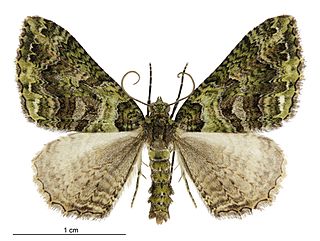
Austrocidaria similata is a species of moth of the family Geometridae. It endemic to New Zealand.

Coprosma petriei, commonly mirrorplant, is a mat-forming shrub native to New Zealand, Polynesia, Australia, the Juan Fernández Islands and Hawaiʻi. It is a hardy wind pollinated plant that is 0.1 m (4 in) by 0.5 m (20 in). Seeds mature in August and the plants only produce either male or female seeds; they are not self-fertilizing.
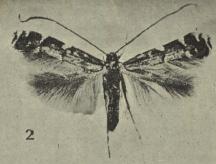
Acrocercops zorionella, also known as the karamu leafminer, is a species of moth in the family Gracillariidae. It is endemic to New Zealand.
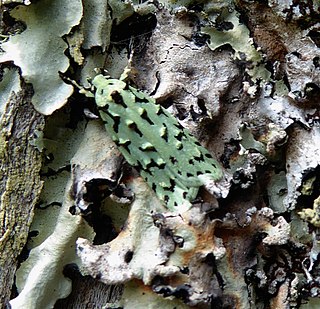
Izatha peroneanella, also known as the small lichen moth or the green lichen tuft, is a moth of the family Oecophoridae. It is endemic to New Zealand, where it is found throughout the North Island, other than the Aupouri Peninsula of Northland.

Coprosma rotundifolia is a native forest shrub of New Zealand found on the North, South, and Stewart Islands.
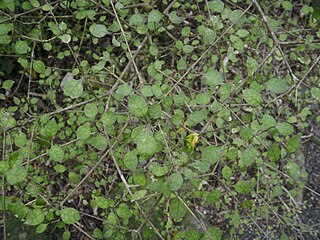
Coprosma areolata, commonly called thin-leaved coprosma, is a shrub that is native to New Zealand. C. areolata grows in wet, lowland forest and can also grow in exposed places. Coprosma is from the Greek kopros 'dung' and osme 'smell', referring to the foul smell of the species, literally 'dung smell'. And areolata is netted, with a network pattern between the veins.

Planotortrix notophaea, the blacklegged leafroller, is a species of moth in the family Tortricidae. It is endemic to New Zealand. It was also present near Sydney in Australia, but this population is thought to be extinct.
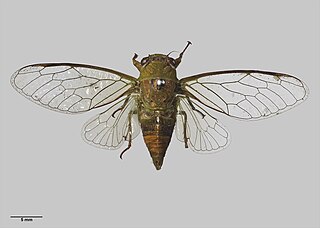
Kikihia ochrina is a species of insect endemic to New Zealand. This species has a three-year life cycle and adults are bright green in colour and are most commonly seen in the month of April in the North Island.

Lake Opuatia is a small lake in the much larger Opuatia wetland, which drains from the west into the Waikato River. It lies near the foot of a long valley drained by the Opuatia Stream.
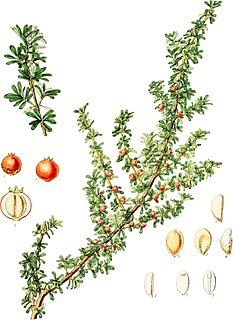
Coprosma cuneata, is a shrub in the Rubiaceae family, native to New Zealand.

















